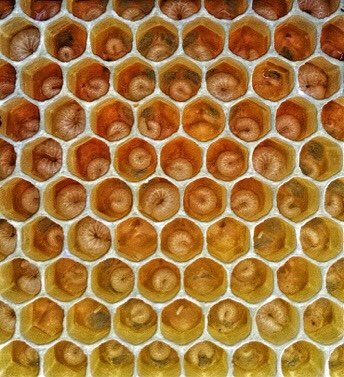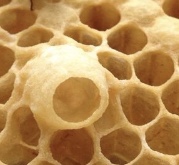So your Hive is queenless…
As we prepare for the coming spring hive inspections, one item on the beekeepers checklist “Is the hive Queen right?”

One reason this is so critical at this time of the year, is that without a surviving queen this early in the year and no brood to create one, the hive cannot make worker bees, and what usually happens without a beekeepers action is a laying unfertilized worker bee, which only produce drones.
Before we get into what actions need to happen there are a few unique traits about a queen bee development that every beekeeper should know about. Normally for worker bees development, after fertilized eggs are placed into their cells by a fertilized Queen, eggs/Larvae are fed the first 3 days only royal jelly by worker bees. After 3 days or so they are fed honey and pollen. This is not the case for queen bee larvae. 
If a hive is queenless, getting ready to swarm, or supersede the workers will build what we like to call emergency queen cells. Instead of switching their diet they are only ever fed royal jelly, which causes the brood in these special cells to turn into queens.

It is a very time sensitive process, and workers must identify their lack of a queen within their first couple days so they can start the process of developing at least 5 queen cells from the dead queen’s young larva. It is a very precarious and vulnerable position for the hive. The first thing a beekeeper might notice when comparing a queen right hive to a queenless hive is the higher pitched buzzing noise heard after cracking open the hive lid. Most healthy hives are able to create and maintain an emergency queen cell. However at times like in the spring there may not bee any young larvae that have not already gone through the conversion process into a worker bee, that can be developed into a queen.
A beekeeper at this stage has a few options:
- Cull the hive, which can open up hive resources quickly for a new split or package. Quickest recovery if resources are available.
- Combine the hive, with another queen right hive. This process has to be completed with care to limit fighting and possibly the risk of killing the queen as the bees sync up with the smell from the queen right hive.
- Introduce a frame of eggs and young larva from a queen right hive. This is a more natural approach and while it may take longer to develop a laying queen she is most likely to be accepted if she survives.
- Introduce a caged mated Queen to the queenless hive. This is the quickest way to turn around a queenless hive, but requires access to a caged mated queens either raised and maintained by the beekeeper in a queen bank, or purchased from another beekeeper. The only risk is the queen not being accepted by the hive, or even being superceeded shortly after laying her first few eggs. It is possible the hive is queen right with a virgin queen so it is important to observe the reaction of the worker bees when you place the caged queen on top of the frames. Are they streaming out to great the new queen, or (if a queen right hive) are they acting aggressive and trying to ball and sting the caged queen. It is important to understand this to prevent loss of your new queen. So if in doubt ask for help.
Unfortunately it is not obvious that a hive is queenless, and it is commonly missed by new beekeepers. Here are a few symptoms that can tip you off.
Symptoms of a Queenless Hive
- Lack of eggs & brood, while coming out of spring or going into winter it is common for hives to suppress brood rearing until resources and temperatures are just right. However there should be an abundance of eggs and brood most other times of the year. Up to 2,000 eggs a day at the hives peak each day. However if the hive has a virgin queen, there will be a lack of eggs and brood too. After she mates and develops she will get busy laying her eggs.
- Fewer bees, for the same reasons above, a hive during the summer will loose 1500-2000 bees a day as part of the lifecycle. So in a hive of 30,000 to 60,000 bees this change can be noticeable. However it is more apparent when compared to a queen right hive.
- Increase in honey and pollen, by its self it is not a sure sign, but keep in mind as worker bees develop there will be an imbalance of workers gathering honey and pollen with no young workers to back fill the other hive jobs. During honey flow this can also be the case.
- Change in behavior or temperament, a queenless hive will make a high pitched wine verses a lower pitched roar. They will be more agitated and nervous. They are in survival mode.
- Queen cells or cups, this is a sure sign of a healthy hive and if combined with other symptoms above your hive is on its way to correct the course. However a healthy hive will typically have several empty queen cups built and torn down, so also look for eggs or larvae in the cup.

- Laying workers, are a last effort for survival of a queenless hive. Unfortunately workers are unfertilized and can only lay drone eggs. Her abdomen is shorter, so you will see more than one egg in the cell usually on the sides as she can’t reach the bottom. Once there is a laying worker the hive is usually culled, however some beekeepers have been successful in turning the hive Queen right.

Beekeepers should always be on the lookout each hive inspection for queenless hives, as they may need more attention and help. Hopefully the above information can help your hives through this vulnerable time.
Are you new to Beekeeping? Interested in becoming a first year beekeeper? Check out our Beginning beekeepers class this March. Get registered here.


